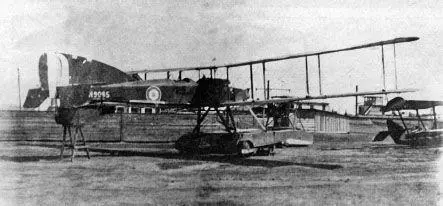The docks at Novorossisk during the evacuation.
Thousands of bodies were found in the streets every morning. The Cossack troops had arrived at Novorossisk with their horses; when they were told that there was no room for the horses on the ships they shot them rather than allow them to fall into the hands of the Reds. The docks became littered with thousands of dead horses. General Milner, the commander of the British Forces in the Black Sea, arrived in Novorossisk with a battalion of the Royal Scots Fusiliers to oversee the withdrawal, but things were so chaotic that little could be done. Two British tanks had been kept back and they were used to cover the evacuation. Captain Anderson described the scene in Novorossisk:
We stayed there three weeks and I will never forget the terrible confusion and the appalling pitiful sights as the refugee ships sailed wives and families going and their men folk remaining to meet again heaven knew where. [7]

The British battleship Emperor of India . During the evacuation of Novorossisk, the Emperor of India bombarded Red Army troops waiting outside the port.
The British and French Navies had warships in the harbour. During the evacuation, the British battleship Emperor of India and the French cruiser Waldeck Rousseau opened fire on Budenny’s forces waiting outside the port.
Two Sopwith Camels had been brought to Novorossisk on board the Baron Beck and they were assembled ready to fly in an emergency. The long, straight breakwater at the entrance to the harbour was the intended runway, but when the seaplane carrier HMS Pegasus arrived in the port the Camels were dismantled on 26 March and shipped out. The remainder of the RAF men were taken on board HMT Hanover on 26 March and the ship sailed at 23.00 hours. On 27 March, the Red Army entered Novorossisk and captured an enormous amount of British equipment that had not been destroyed. They also captured thousands of White Army troops who had not been able to get away.
The Hanover reached Theodosia in the Crimea on 27 March. Because of the situation, the plan for Anderson to take over A Flight was abandoned. The RAF presence in the Crimea was reduced to an advisory and training role. This reduced group was to comprise eighteen officers and thirty-five other ranks. Most of the RAF men left the Crimea on board SS Katoria on 31 March. Collishaw and Kinkead left in early April after clearing up the accounts for the units they had commanded. General Holman handed over command of the British Military Mission to General J. S. J. Percy and left the Crimea for Constantinople on 29 March with General Denikin.
CHAPTER TWENTY
CONCLUSION
Wrangel had replaced Denikin to become the supreme commander on 4 April 1920. What was left of the Armed Forces of South Russia was concentrated in the Crimea. The Perekop Isthmus, connecting the Crimea to the mainland, is only five miles wide at its narrowest point. Wrangel was able to create trench lines across the isthmus to hold the Red Army at bay. There were about 35,000 troops left in the Crimea, and Wrangel mounted a major effort to re-equip and re-train the White forces. He tried to create a more disciplined force, as he blamed indiscipline, corruption, and looting for much of the misfortune that had befallen Denikin. On the political side, he also tried to create a viable consensus on the way forward and on the question of land for the people.
The British Military Mission had been reduced in size, but the British guaranteed to support Wrangel in the Crimea. Small amounts of military supplies, including tanks and aircraft, were delivered to the Crimea. The RAF contingent, under the command of Major Clemson, was only for advice and the limited provision of training. The full might of the Red Army was not immediately directed against the Crimea, as the Polish Army had opened a major assault against the Soviets. On 25 April, three Polish Armies attacked western Russia. At first, the Poles were successful, forcing the Red Army to move forces from south Russia to the new theatre.
The British government warned Wrangel against taking advantage of the weakness of the Soviet forces in south Russia and launching an attack on the mainland, but Wrangel ignored this warning and on 7 June 1920 the renamed Russian Army broke out of the Crimea and quickly captured the Taurida. On 11 June, the British withdrew the remaining Military Mission, including the RAF. Wrangel was told that Britain would now be neutral in the Civil War. But the French government continued to support Wrangel. To start with, the White advance was successful, but with only limited numbers of troops and equipment it soon ground to a halt. Wrangel was undoubtedly the best of the White generals in the south, but there was a limit to what even he could achieve.
By September, the Red Army had driven back the Poles and then been driven back again themselves. Both sides were keen to reach a settlement, and talks started in September. This released large numbers of troops to use against Wrangel. In October, the Russian Army was back to the Crimea. This time, the full might of the Red Army was directed against the Russian Army. Wrangel recognised the inevitable and took care to organise a full evacuation. He had heard the stories of the evacuation from Novorossisk and did not want this to happen again. By early November, the Red Army had broken through the Perekop Isthmus with heavy casualties. A major evacuation was mounted and by 16 November, 146,000 people had been lifted off and had crossed the Black Sea to Constantinople. The Russian Civil War in south Russia was over.
The reasons for the failure of the White Armies in south Russia were many and varied. General Denikin’s Army was made up of a number of groups who had different views and aims. Denikin’s view of ‘one Russia indivisible’ did not agree with the views of the Don, Kuban, or Terek Cossacks, or with the Ukrainians, who all wanted to create their own breakaway states. Many of the working classes in the White areas supported the Soviet state. When Denikin advanced towards Moscow he never had enough forces to control the land he had captured. The rear areas were in total chaos by December 1919. The corruption that followed the White Armies halted any attempts at logical organisation. After years of war and civil war, famine, and pestilence, the vast majority of the population just wanted peace at any price. Large numbers of people conscripted into the White Armies deserted. Although the same could also be said of the other side (two thirds of the troops conscripted into the Red Army deserted), at the end of the day, the government in Moscow had more men and resources. By late 1920, General Wrangel faced a Red Army with a paper strength of five million.
The British had played a major part in the fortunes of the Armed Forces of South Russia. The numbers of people involved were small, but the amounts of equipment supplied were enormous. 198,000 rifles of various types were supplied, along with 6,200 machine-guns and 500 million rounds of ammunition. Heavy equipment given to Denikin’s troops included 1,120 artillery pieces, plus shells and at least seventy-four tanks. Hundreds of thousands of uniforms and boots were supplied. Over one million pairs of socks were lost at Novorossisk alone.

Short 184 N9085 after it had been captured by the Reds in 1920.
There is no really hard figure for the total of aircraft supplied. A number of aircraft that were being prepared for shipment were never sent after the Army was forced to move to the Crimea. Also, aircraft that were supposed to have been sent never seem to have arrived. Other aircraft were scrapped on arrival, and six SE5As that were sent were never used, as the wrong propellers arrived with the aircraft. At least 100 RE8s were sent, with seventy-one being issued to the Russians. How much use was made of them is a different question. Counting the aircraft scrapped or never issued, at least 184 aircraft were received in south Russia; of these, at least 134 were issued to the Russians. The rest were either used by 47 Squadron or the Training Mission, or remained in storage. This figure does not include the aircraft used by 221 and 266 Squadrons. Only the RE8s and the Short 184s used by 266 Squadron were new aircraft; the rest were all second-hand ex-RAF stocks.
Читать дальше














